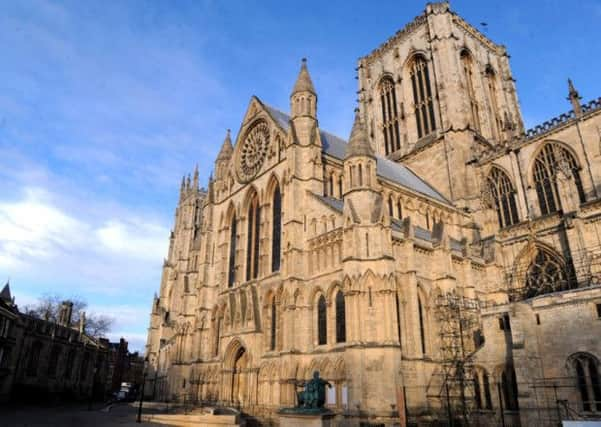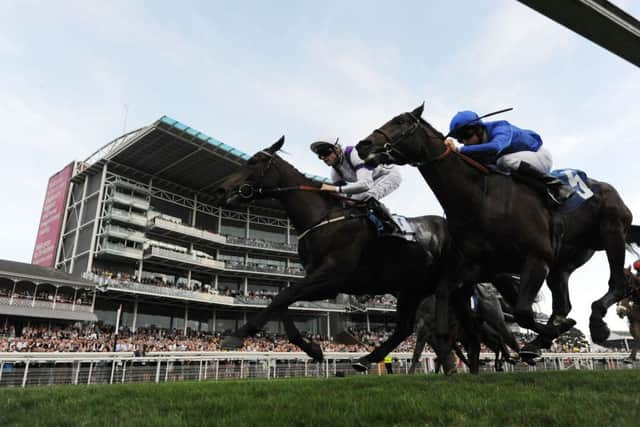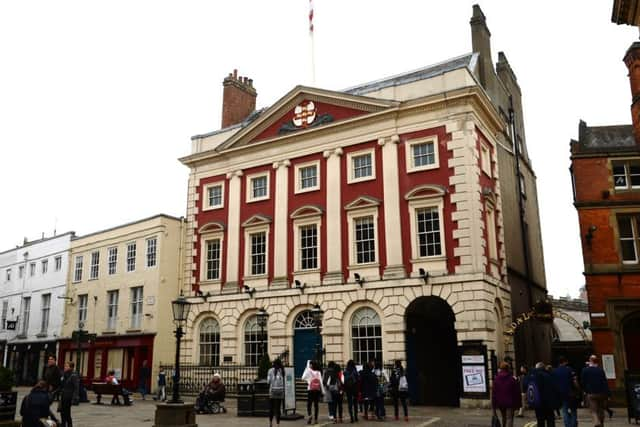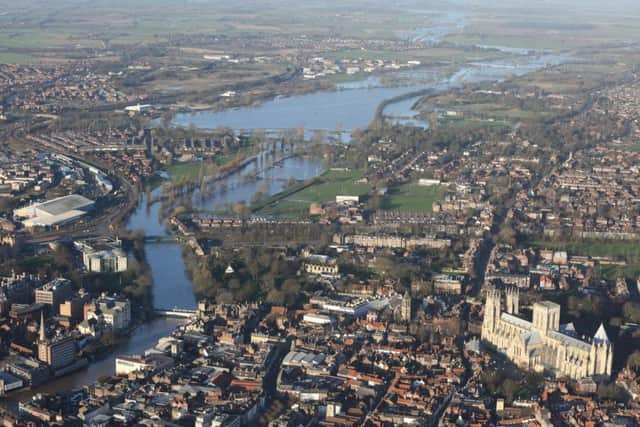Where history meets happy: our definitive guide to York


A is for AIR MUSEUM - The York Air Museum at Elvington is the largest of its kind in Britain and is home to more than 50 aircraft, including Spitfires, Hurricanes, Messerschmitts, deHavilland Mosquitos and a Hawker Siddeley Nimrod. The museum also hosts an archive of important collections and special exhibitions such as Bomber Command and Pioneers of Aviation.
B is for BOOTHAM CRESCENT - The home of York City since 1932, Bootham Crescent is a traditional-style football ground close to the city centre and once hosted a crowd of 28,123 for an FA Cup tie v Huddersfield Town in 1938. York’s average crowd last season was 3,555 and the club is preparing to leave Bootham Crescent in 2017 to share a new community stadium at Huntington with rugby league club York City Knights.
Advertisement
Hide AdAdvertisement
Hide AdC is for CONFECTIONERY - York is the birthplace of some of the world’s most famous sweet brands that were developed in the city by Rowntree’s and Terry’s. The Terry’s factory closed in 2005 with production of Chocolate Oranges and All Gold chocolates moved overseas. Rowntree’s, which is now part of the vast Nestle empire, still makes Kit Kats, fruit gums, fruit pastilles and Yorkie bars. An estimated 418 KitKats are consumed every second worldwide.


D is for DESIGNER OUTLET - Situated on the outskirts of York just off the A64 at Fulford, the York Designer Outlet features over 120 shops selling discounted fashion and homeware. Unlike many similar out-of-town shopping centres, the success of the Designer Outlet has not come at the expense of York city centre, which remains a major shopping destination.
E is for EBOR MEETING - The Ebor Festival is a four-day horse racing meeting held every August at York racecourse that was first held in 1843. The highlight is the Ebor Handicap, a race open to horses aged three years or older and run over a course measuring one mile and six furlongs. Only one horse has won it twice: Flint Jack in 1922 and 1923.
F is for FLOODS - Sitting on the Rivers Ouse and Foss on the plain of the Vale of York, the city has always been susceptible to flooding but has endured some of the worst inundations in its history in the last few years. Heavy rain last month saw much of the city centre underwater between Christmas and New Year but the city is now all-but fully open for business, including the King’s Arms, the world’s most-flooded pub.
Advertisement
Hide AdAdvertisement
Hide AdG is for GOTHIC PILE - Christians have worshipped on the site of York Minster since 627 but work on the current building did not begin until 1220. Construction continued for another 250 year. The Minster was badly damaged during the Reformation and the English Civil War and in 1984 suffered a devastating fire when it was hit by a lightning bolt. Over two million visitors file through its doors every year.


H is for HEWORTH - The birthplace of Dame Judi Dench hosted a drama of historic proportions in 1454 when the Percy and Neville families got it on following a local wedding in a battle that is widely recognised as the opening conflict of the War of the Roses.
I is for IMPHAL - York has been a garrison town since Roman times and continues to play an important military role with the 1st (UK) Division of the British Army based at Imphal Barracks in Fulford. The barracks are named in honour of the successes enjoyed by the West Yorkshire Regiment against the Japanese in the Battle of Imphal, India, in 1944.
J is for JORVIK - The name York is derived from the 9th century Norse word Jorvik, which in turn is a corruption of the Roman name for the city, Eboracum. Since 1984, the history of York has been told at the Jorvik Vikings Centre on Coppergate, which was badly damaged by the floods in December 2015.
Advertisement
Hide AdAdvertisement
Hide AdK is for KATE ATKINSON MBE - Author Kate Atkinson rose to prominence with her debut novel Behind The Scenes At The Museum, which is largely set in her home city with references to the Castle Museum. Ms Atkinson has written eight other novels, including a successful series starring the detective Jackson Brodie which has been made into a popular TV mini-series, Case Histories.


L is for LEICESTER - There was an outcry in York two years ago when Leicester laid claims to one of the city’s most famous sons, Richard III whose remains were found beneath a car park in the East Midlands town. Richard was killed at the Battle of Bosworth Field in 1485. The song Bring Him Home from the musical Les Miserables was not inspired by York’s claims for the humped-back skeleton. But it could have been...
M is for MASSACRE - In 1190 the entire Jewish population of York was massacred in anti-Semitic riots centred on Clifford Tower, where over 100 Jewish people are believed to have committed suicide rather than subject themselves to the savage violence of rioters. Around 50 others were burned to death when the rioters set fire to the Tower.
N is for NIGHTLIFE - The many pubs, bar and nightclubs in the city have made York a popular venue for revellers, including stag and hen parties who stumbled their way through the historic streets most weekends. Drunken behaviour continues to be a source of concern for locals, some of whom have called for the police to ban blow-up dolls and inflatable penises from the city centre. Spoilsports.
Advertisement
Hide AdAdvertisement
Hide AdO is for OBSERVATORY - While many revellers end up in the gutter, some at least get to look up at the stars, although not as closely as visitors to Yorkshire’s oldest working observatory in Museum Gardens. The observatory was built in 1832 to improve timekeeping and make the city more efficient at welcoming visiting stagecoaches, few of which are thought to have carried rude inflatables.


P is for ST PETER’S SCHOOL - This ancient seat of learning was founded in 627 and has educated thousands of youngsters in the intervening 14 centuries. Its most famous old-boy is Guy Fawkes, one of the key figures involved in the Gunpowder Plot of 1605. Fawkes was executed on January 31, 1606, when he leapt from the gallows rather than endure the full horrors of the sentence that he be hung, drawn and quartered.
Q is for QUAKERS - York has a long tradition of Quakerism going back to 1651 when George Fox, the founder of the Society of Friends, was evicted from the Minster for preaching against the establishment. York’s most famous Quaker is philanthropist Joseph Rowntree, the chocolatier. There are two Quaker schools in York, Bootham School and The Mount.
R is for RAILWAYS - The decision by George Stephenson to run his railway line between Newcastle and London through York in the 1830s helped establish the city as a force in the industrial revolution. The railways brought tourists in record numbers and saw the development of ancillary rail industries that created thousands of jobs. York is home to the outstanding National Rail Museum.
Advertisement
Hide AdAdvertisement
Hide AdS is for SHAMBLES - The most picturesque - and photographed - street in York is a narrow passageway that once housed butchers shops but is now home to cafes and souvenir outlets. The hooks on which butchers hung their wares from the 14th century can still be found on many shop fronts.
T is for THEATRES - Theatre-goers are well served in York, which has three large venues that play host to travelling productions and performers: the Theatre Royal, which first opened in 1744; the Grade II-listed Grand Opera House; and the council-owned Barbican, which is home to international snooker tournaments.
U is for UNIVERSITY - Plans for a university in York were first drawn up in 1617 but it would be another 446 years before the first undergraduates presented themselves at this highly regarded educational establishment. Its alumni includes Harriet Harman MP; the current President of Portugal, Anibal Cavaco Silva; author Anthony Horowitz; and Greg Dyke, the chairman of the Football Association and and former BBC Director General.


V is for VIKINGS - Norse invaders first conquered York, whose name had become the Anglo-Saxon Eoforwic from the Roman Eboracum, in 866 when Ivan the Boneless led a great heathen army north from East Anglia. Over the next 200 years the Vikings traded across much of the known world from York, including the Baltic countries, the Persian gulf and Istanbul. There is no truth in reports that the Viking leader was known as Ivan the Boned until he took a walk down The Shambles.
Advertisement
Hide AdAdvertisement
Hide AdW is for WALLS - York has been a walled city since Roman times but the 3.4 kilometres of walls that remain date back to the 13th and 14th centuries. The walls featured four main gates, known as bars -Bootham Bar, Micklegate Bar, Monk Bar and Walmgate Bar. The original Roman walls were buried beneath earth banks by the Vikings are continue to be excavated.
X is for X FILES - York is worthy of a whole series, never mind a single episode of the popular sci-fi TV series because of the extraordinary amount of paranormal activity in the city. York has more ghosts (140) than any other city in Britain and ghost tours are a popular attraction for visitors. As are spirits (see N for nightlife…)
Y is for YORK, HOUSE OF - Three members of the House of York were crowned King of England: Edward IV (1461-1470 and 1471-1483), Edward V (April 9 to June 25, 1483) and Richard III (June 1483 to August 1485). Edward IV drowned in a butt of malmsey wine; Edward V was killed as one of the Princes in the Tower, probably by his uncle, Richard III, who got his comeuppance by being made to spend the rest of eternity in Leicester.
Z is for ZUMBA - There are endless ways to keep fit in York but Zumba classes at the York Dance Works on Redeness Street are hugely popular, especially with mums who can take advantage of a free creche. It’s just a fiver for a one-hour session, every Friday morning at 9.30.